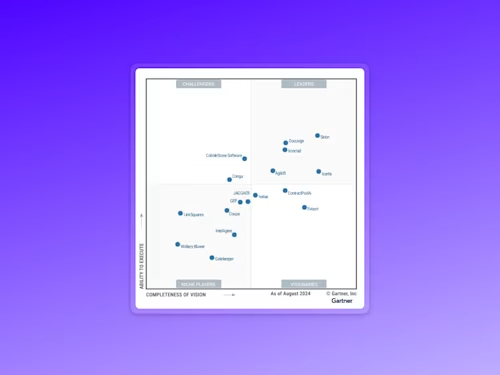
How to Choose the Right E-Signature Provider
Use these industry analyst criteria to evaluate e-signature vendors to meet your unique signing requirements now and in the future.


The need for mobile and touchless workflows has spurred organizations across a wide range of industries to adapt critical workflows and evaluate new technologies to support them. Top new technology investments during the pandemic included web conferencing, collaboration tools, and electronic signature.
How should you evaluate an e-signature vendor?
There are several criteria to evaluate before you choose the right vendor to meet your unique e-signature needs. The first step is determining what your needs are. Begin by asking yourself:
What are the documents, agreements and forms that you currently route manually or on paper that you want to manage electronically? Examples may include non-disclosure agreements, sales contracts, new hire documentation, invoice processing, purchase orders, expense reporting, vendor agreements, internal compliance and letters of intent.
How many of these documents do you create and route weekly or monthly?
Do you want a solution that integrates with the software you already use, like Salesforce, Oracle Netsuite, SAP Ariba, Workday, Google Workspace, Microsoft, Slack and Quickbooks?
Do your recipients need to be able to access documents you send for signature on mobile or tablet devices?
Would you like to be able to request payment at the time of signature?
How many people at your organization send documents for signature?
Are you thinking about building customer integrations for e-signature that would require access to the vendor's application programming interface (API)?
Two recently published analyst reports, Gartner’s Market Guide for Electronic Signature and Forrester’s Now Tech: Digital Signature and Trust Services, Q1 2021, also offer useful insights into which factors you should consider in evaluating e-signature vendor capabilities and fit.
Criteria to consider when evaluating e-signature vendors
Product functionality
If you are seeking a basic e-signature solution, a number of vendors may potentially meet your needs. However, if you require advanced functionality, greater flexibility, and end to end agreement workflow, the choices are more limited. Forrester segments the market based on solution capabilities, with those vendors in the “digital trust services” and “digital transformation” platform segments offering several compelling advantages over those in the “e-signature specialist” and “PKI specialist” categories. Make sure you fully understand your current functionality needs, and consider how they may evolve in the future before selecting your e-signature partner.
Vendor size
Forrester segments the marketplace based on annual revenue, with the largest vendors falling in the $40+ million category. These vendors are well-established, maintain a global geographic presence, and typically offer deep functionality and expertise across a range of industry verticals.
Geography
If your firm operates internationally or within multiple regional jurisdictions, look for a provider with a strong global footprint, as well as an expert understanding of local regulatory requirements such as eIDAS in the European Union.
Integration capabilities
To maximize efficiencies, the ability to integrate with leading digital platforms using APIs and software development kits (SDKs) is paramount. According to Gartner, “the depth of integration and simplicity of use of electronic signatures within the chosen business process platform are often key factors in vendor selection.”
Compliance risk
Firms in highly regulated industries such as healthcare and financial services may be subject to stringent data security and identity assurance requirements, depending on the jurisdictions in which they operate. Regulations include data privacy, know your customer (KYC) requirements, and authentication protocols (like those prescribed under the European Payment Services Directive 2 (PSD2)).
Data security
Incidents involving identity fraud, data breaches, and threats to data integrity have ballooned in recent years. Choose a vendor that offers sophisticated security features like audit trail preservation, support of advanced and qualified e-signatures, and certificate management.
Customer and employee experience
Now more than ever, convenience and ease of use are highly valued by both customers and employees. According to Forrester, “forty percent of surveyed global purchase influencers say that improving the experience of their customers is a high or critical priority over the next year.”
Selecting the best e-signature solution
Gartner recommends sticking to a deliberate path in evaluating and selecting the best e-signature solution provider to meet your organization’s unique needs including:
Understand your business requirements and evaluate all potential use cases across your enterprise. Think about where e-signature can have the most impact across your organization, and map out the process. Note that needed functionality and process requirements can vary widely depending on whether the use cases are business-to-business (B2B), business-to-consumer (B2C), business to employee (B2E), or even employee to employee (E2E).
Assess your technology, compliance and security requirements. Once you’ve determined which use cases will provide the greatest value and impact, scope out the requirements in these key areas. Assess your platform integrations, account for whether you operate in a highly regulated industry, and determine the specific regulations, data security and privacy requirements of the geographic jurisdictions in which you operate.
Consider which licensing model will most fully and cost-effectively meet your needs. Some providers offer a range of licensing options and multiple versions of their products to meet budget and use case needs. Companywide solutions across multiple use cases, platforms and departments are often best addressed by "enterprise versions" of the product. This is due to the built-in compliance and security features these full-service solutions offer, along with the ability to integrate fully with the most common Software as a Service (SaaS) platforms.
Select the vendor that checks all the boxes. After creating your short list, take advantage of a free-trial period or developer sandbox account so that you can get a feel for which tools will work for your organization. If you are looking to integrate an electronic signature solution with existing software, speak to the vendor’s professional services team to review best practices and services packages to help you get up and running quickly. Look for the best combination of attributes to meet your specific needs, with a focus on those that have developed specialized use case solutions for your industry.
As customer and employee expectations continue to rise, the need for digital transformation has never been greater. E-signature solutions are an integral component of the digital ecosystem and selecting the right vendor to meet your organization’s unique needs is a crucial step.
Related posts
 Insights for LeadersUpdated Feb 11, 2025
Insights for LeadersUpdated Feb 11, 2025 Insights for LeadersUpdated Feb 11, 2025
Insights for LeadersUpdated Feb 11, 2025How to Electronically Sign and Send a PDF

Liveness Detection for ID Verification

How to Electronically Sign and Send a PDF
Discover what's new with Docusign IAM or start with eSignature for free


